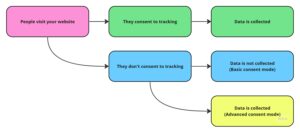Consent is Key: What is Google Consent Mode v2?
If you work with Google products on a day-to-day basis (Google Ads, Google Tag Manager, Google Analytics), or just rely on Google products to carry out (part of) your job, or even if you just work with websites and digital tools, you probably have heard of Google Consent Mode v2.
On its surface, Google Consent Mode v2 is a mandatory feature from Google coming into play from March 2024, but questions about data security and privacy lie under the hood.
This article explores what Google Consent Mode v2 is, what it means for charities, and how you and your charity can use Reason Digital’s solution to combat your beneficiaries and service users’ data against being non-consensually accessed.
Consent is key: What is Google Consent Mode v2?
Google Consent Mode v2 is a code update to Google tools (Tag Manager, Google Analytics, and Google Ads) that affects how consent is processed and how tags fire. Functionally, little will change on your website or cookie banner if they are correctly integrated with the new consent mode; it will still look and work as it does now. What will change is how tags fire in Tag Manager. Google Consent Mode v2 is a new approach to website consent, and Google is making it mandatory for all those who use Google Ads. Google Consent Mode v2 does provide added benefits to your charity by better controlling how Google processes visitor data, and it is a better mechanism for processing website visitor consent.
The hard deadline of 6th of March for implementation is based on new GDPR (General Data Protection Regulations) laws coming into effect in the EU and EEA (The Digital Markets Act). The DMA legislation requires gatekeepers such as Google to obtain explicit consent for the collection and use of European citizens’ personal data. Upgrading to Google Consent Mode v2 will enable you to continue to process visitor data from the EU/EEA and the UK. Google has warned that those who do not implement Google Consent Mode v2 by this date may run the risk of impacting the accuracy and efficacy of their Google Analytics and Google Ads.
Lastly, if you do not follow the General Data Protection Regulation and the EU User Consent Directive, you could risk a rather hefty fine for not having informed digital consent from your users.
Why is Google Consent Mode v2 problematic?
After reading the above, it’s clear that Google Consent Mode v2 is here to stay and it must be taken seriously. Not to mention the benefits we’ve mentioned earlier. So why are we writing a blog about how you could potentially work around it?
To put it simply, it’s evident that serious attention must be paid to Google Consent Mode v2’s implementation and the changes it makes to data collection, despite its touted benefits. First, it’s crucial to understand the differences between the two versions of consent mode v2 offered by Google. The first version, known as “Advanced consent mode,” operates by collecting user data even without explicit user consent. Google markets this as “advanced” due to its ability to supplement consented data with additional information that users haven’t explicitly agreed to provide. This branding might sound appealing, but it’s essentially non-compliant with privacy standards and should likely be avoided. In a nutshell, “Advanced consent mode” is like saying no to being photographed but still having someone point their camera and snap a shot of the back of your head anyway.
On the other hand, there’s “Basic consent mode,” which operates differently. In this version, no data is collected until the user explicitly gives consent. Despite its name, “Basic consent mode” is actually the preferred option as it ensures that Google doesn’t collect any data until the user has granted them permission. It’s a matter of clarity and privacy compliance, where the seemingly “basic” option actually aligns more closely with privacy standards and user expectations.

A flow-chart modelling Google Consent Mode v2
How can you work around it?
This lack of clear choice and grey area around cookie consent is concerning, especially for charities who rely on trust. But don’t worry, we’ve found a way to block these sneaky “advanced” consent toggles to give you real control over your users’ privacy. It’s crucial to both adopt Google Consent Mode v2 and make these modifications to preserve users’ privacy. If you don’t, you risk missing out on crucial data insights for not adopting, and potentially jeopardise users’ trust if you don’t limit the data that Google can collect from those who do not accept cookies.
Behind Google’s seemingly innocent data collection lies a cunning tactic to gather more information for advertising. But let’s not surrender your beneficiaries’ and supporters’ privacy without a fight.
Other times big tech giants played with customer data
Tech giants like Facebook (Meta) have a history of playing fast and loose with customer data, and recent revelations about charities in Britain sharing sensitive browsing details with Facebook for targeted advertising underscore the importance of safeguarding user privacy and obtaining proper cookie consent. The data shared included users’ interactions with content related to mental health issues, such as depression and self-harm, raising concerns about the privacy of individuals seeking support online. Despite assurances from Facebook about filtering out sensitive data, past incidents suggest these measures aren’t foolproof.
These developments highlight the urgent need for organisations to understand the implications of data-sharing practices and for regulators to enforce stricter measures to protect user privacy in the digital realm. Considering Google’s decision to potentially endanger users’ data in service of heightened ad revenue, Reason Digital is prepared to step in and help charities navigate the compulsory migration over to Google Consent Mode v2 while making sure that consent remains binary, removing the non-consensual grey area of data collection that Google’s new update unfortunately includes.
